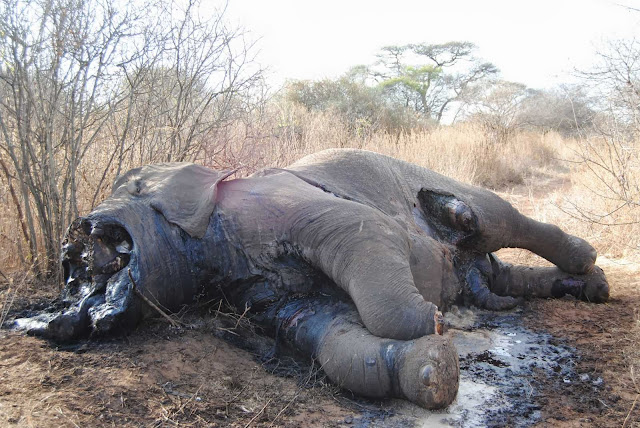.jpg) |
| Mzee and Bernard Shirima, at Naitolia Camp, with the carcass of a young bull elephant killed by poachers on September 27 |
Only ten days ago, this young bull elephant came into our safari camp at Naitolia, Tanzania to die. Mad with pain and terror, he was fleeing poachers who had shot him for his tusks, as he and other young bulls were feeding on open land near the town of Makuyuni, north of Tarangire National Park.
Maybe he knew the forest was a place of safety where the men with guns could not follow. Perhaps it was familiarity that drove him there — he and his kin may well have browsed peacefully in this spot since they were calves, 20 years or so ago. We will never know. What we do know is that late on Friday, September 27, the elephant finally succumbed, dying in the place he had sought sanctuary.
Only metres away in Naitolia Camp, the Masai staff were first drawn to his body by the bickering sounds of hyenas and vultures, jackals and Maribou storks. The opportunist animals were clambering over the elephant’s carcass to find a soft spot, some damage in the tough hide where they could feed.
In Tanzania, a definitive set of wildlife laws applies at the moment of death. Horns and tusks — once integral parts of living, breathing, majestic animals — become illegal but highly valued commodities. So clear cut are the laws that the act of just moving any part of the dead animal, especially ivory, is a felony, one so serious that the offender may be jailed or beaten on the spot.
The Masai staff alerted our office in Arusha and we immediately called the Department of Wildlife. Rangers arrived within hours. They began the gruesome work of chopping and hacking the carcass with axes and machetes, an ironic parody of the poaching activity that has claimed more than 30,000 elephants in Tanzania over the past five years.
The rangers had to remove the tusks so they could not make their way into the illicit ivory trade. First, the animal parts will be stored in the department’s district offices in Monduli, along with other confiscated wildlife products — leopard skins (some so young as to hardly cover the table they’re stacked upon), lions’ manes, pelts covered in porcupine quills. Later, the tusks will be moved to a warehouse in Dar Es Salaam, there to join the thousands of others seized during raids, or harvested from dead animals such as this one.
 |
| The once vibrant elephant after he died and wildlife rangers removed his tusks |
Why the exponential increase in elephant poaching in Tanzania since 2008? And what about the brutal slayings of wildebeest, which migrate out of Tarangire National Park at the onset of the short rains to calve on the plains east of the park? The wildebeest population has been experiencing a sickening free-fall, declining from an estimated 25,000 animals before 2008 to now just over 5000. Why are the Masai steppes and traditional grazing grounds no longer safe for migrating herds?
The poachers responsible for these latest elephant killings were caught less than a week later trying to sell a tusk in Makuyuni. They were well known in the town, often seen operating their motorbikes as taxis and posing as fishermen.

2 comments:
Hello Simon,
Thank you for creating this blog. I am sure that it is going to serve as an excellent way for people around the world to get an "on-the-ground" perspective of what is happening with East African wildlife: the issues, possible ways ahead in doing something to address this urgent and important issue. I'm sure many people will use the "eye-witness" information to try to further the cause of the protection of the environment and wildlife of Africa. I will return regularly to the blog to read your postings and comments posted by readers.
Bob C
Thank you, Bob!
Post a Comment